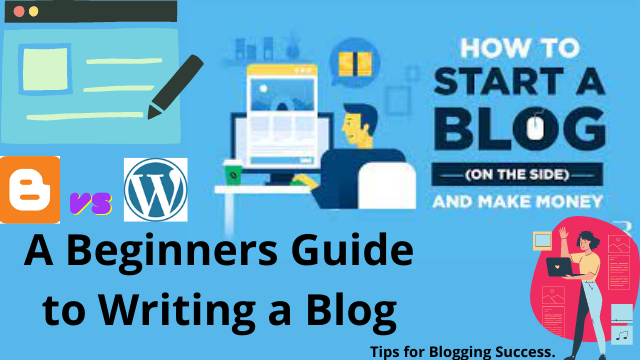A Beginners Guide to Writing a Blog: Tried and Tested Tips for Blogging Success.
The end of 2018 has been the perfect time to launch your own blog, especially if you're looking for a new career. You can start your blog at absolutely zero cost and it's also easy to manage. Plus, with the right tools, it's possible to make money blogging!
This article covers all the basics to help you get started on your journey as an online entrepreneur. From choosing a domain name and hosting service to choosing topics that will attract traffic, this guide will teach you everything you need to know to create a successful blog.
 |
| Blog Writing Tips for Beginners |
Pick a topic
The first step is to pick a topic for your blog. This will be the foundation of your blog and everything you write about will revolve around this topic.
Start by thinking about topics that are relevant to your expertise or interests. It's important to find a niche that you can become an expert in. This will make it easier to build up your audience and establish yourself as a leader in the field. The more time you spend on one topic, the more knowledgeable you'll be about the subject matter.
Once you have chosen a topic, it's time to start writing! Read on for tips on how to attract an audience with your catchy headline, writing style, and visual content.
Choose your niche
The most important and difficult choice you'll make is deciding what type of blog you want to start. If you need help, we've compiled a list of the most popular blogging niches.
Do you want to talk about your favorite hobby? Do you want to write about books? Is this a career change for you and you're looking for ways to share your skills online? Do you want to create a lifestyle blog that provides inspiration or entertainment?
The best way to know what niche is best for your blog is by considering what topics interest you and by seeing if there's an audience interested in those topics. It's also helpful to pay attention and see if any of the most popular bloggers in your niche are publishing new content on a regular basis.
This will help guide your decision when picking out a niche. You may not be able to compete with the big influencers right away, but if they are still publishing new content regularly, it might be worth giving it time before trying something else.
Create an editorial calendar
Once you have your blogging basics down, it's time to start thinking about what content you want to produce. Instead of just writing whatever comes to mind, create an editorial calendar that will guide your blog post topics and distribution schedule.
First, make a list of all the topics or types of content you want to cover on your blog. Then, decide when you want to publish each topic. Perhaps you want to publish one blog post per week on Monday mornings? Or maybe two posts per week with one post on Friday afternoons? Next, break that into individual days. Sunday is traditionally reserved for blogging tasks like checking stats and responding to comments; Monday is typically used for publishing new posts; Tuesday should be focused on social media engagement; Wednesday could be used for ad creation; Thursday is often reserved for other marketing tasks like outreach or email marketing; Friday is typically set aside for research or interviews.
You can use an editorial calendar template like this one for inspiration: This template has space for seven weeks worth of blog topics and includes space for keywords, ad copy ideas, social media engagement ideas, and more.
Figure out what social media accounts will tie into your blog
Your blog is just one component of your online presence. Social media accounts are another important factor when it comes to marketing. Your social media accounts will be the location where you post your blog content, interact with followers, and share other valuable content about your business or industry.
You should take some time to figure out which social media platforms would make the most sense for your blog because different platforms have different audiences and demographics. For example, if you're starting a food blog, Facebook may not be the best platform for you because it doesn't focus on that niche or audience.
Think about which platforms are best for your niche and then create an account! The more places you're presently online, the more opportunities you'll have to reach new customers.
Conclusion
Blogs are a fantastic way to reach a very specific audience. The more you understand your audience, the more successful your blog will be.
In this guide, we have gone through some tried and tested steps to writing a blog post.
The first step is to pick a topic. This should be as specific as possible as this will create a more dedicated audience.
Next, you need to choose a niche for your blog. This should be something that you have experience in and know a lot about.
The third step is to create an editorial calendar so you can plan your posts in advance.
The next step is to figure out what social media accounts will tie into your blog. This could be Twitter, LinkedIn or Facebook, or all three.
The final step is to write your post and promote it on the platforms that you have decided to connect to your blog.



0 Comments